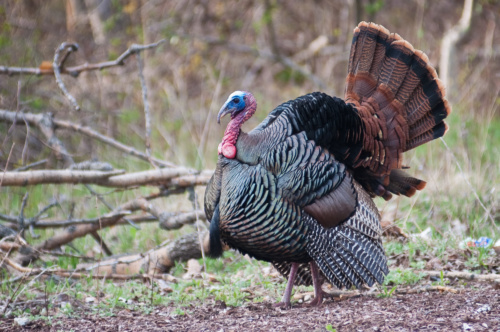With the holidays fast approaching, many folks are beginning to plan their requisite feasts with family and friends. The centerpiece for many a merry meal will undoubtedly be a turkey; indeed, Americans will consume nearly 50 million turkeys on Thanksgiving and about half as many on Christmas. Given that the average American consumes over 15 pounds of turkey each year, I thought it would be interesting to briefly explore the natural history of this ubiquitous bird.

Wild Turkey photo by Twan Leenders
The domestic turkey that you buy in the grocery store is the same species as the wild turkeys that you might see strutting through a local field or woodland; Meleagris gallopavo. However, that bulbous, frozen bird in your shopping cart is not a direct descendant of those more slender, skittish fowl found in our backyards, but rather from a subspecies found in Mexico. Ancient mesoamericans domesticated this subspecies about 2000 years ago having realized the value of its meat and eggs as food and its feather for decoration. Spanish explorers sailed home with some of these birds in the 16th century, and a number of distinct breeds were then developed and subsequently spread throughout Europe. Theories for the derivation of the common name for these birds center on their introduction into England by “Turkey merchants” via Constantinople (on ships from the Middle East). From there the bird made another trans-Atlantic journey when it was included in shipments of supplies to fledgling colonies in the New World.

Wild Turkeys as painted by Roger Tory Peterson
So if the English colonies (Pilgrims) and the Native Americans (Wampanoag) each had access to their own variety of Meleagris gallopavo for the “first” Thanksgiving feast held in the autumn of 1621 at Plimouth, Massachusetts, whose bird was served? Interestingly, the only historical accounts of this meal fail to mention turkey at all, but rather suggest that the celebratory meal featured duck (then plentiful in the bay area) and venison (a favorite of the Wampanoag)!
Regardless of what’s featured in your feasts with family and friends, learning a thing or two about the natural history of the foods you choose to enjoy is sure to make for interesting dinner conversation!

Wild Turkey pen and ink drawing by Roger Tory Peterson
Sources:
1. http://extension.illinois.edu/turkey/turkey_facts.cfm
2. http://www.eartharchives.org/articles/the-natural-history-of-the-turkey/
3. http://www.scholastic.com/scholastic_thanksgiving/feast/
4. http://www.naturealmanac.com/archive/wild_turkey/wild_turkey.html












